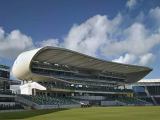
|

"In place of what was once an idiosyncratic, charming, informal, but fairly basic and increasingly decrepit stadium stands a beautiful modern structure, comparable to the very best in the world"
© Arup Associates & Christian Richters
|
|
We are sitting in one of the television commentary booths in the newly constructed media centre of the Kensington Oval and Franklyn Stephenson, described by many as the best West Indian fast bowler never to have played Test cricket, is recounting to me the best over of fast bowling he, perhaps anyone, has ever seen. There is a lilt in his voice and a sparkle in his eyes as he visualises Michael Holding turning at the top of his bowling mark.
"I was sitting there," says Stephenson, who played only eight matches in Barbados before being banned for joining the rebel tour to South Africa, pointing to the right of the Sir Garfield Sobers Pavilion, "and Holding turns, his chest's puffed out, and he blows in like a breeze, his collar flapping, feet gliding, and the ball goes whoop! I am sure [Geoff] Boycott didn't see it."
The routine is repeated four more times, Boycott playing, or just waving his bat in the air, and missing, before being put of misery with the last ball. "Wow, the stump goes cartwheeling," Stephenson says, replaying the movement with his hand, "one, two, three, four ... must have gone half way to the fence."
"Pace like fire, maan." The words that became a West Indian leitmotif were born out of the belly of Kensington Oval. If cricket defines Barbados, the Kensington Oval defines West Indian cricket. Or so it did for close to 50 years when it was the most fearsome symbol of West Indian invincibility. Between 1948 and 1994, when they didn't lose a Test here. Between 1978 and 1993 they won 12 Tests in succession. In this period they beat everyone everywhere, but at the Kensington Oval, they beat them to pulp. Fast bowler after fast bowler ran in to pound the pitch, made out of the hard coral island soil of Barbados, and batsmen were terrorised, crushed, and paralysed out of fear.
But when I ask him if that over to Boycott was the fastest he had ever bowled, Holding, who still looks like he can run in the way he did 30 years ago, shrugs his shoulders and shakes his head. "There is a bit of myth about West Indian pitches,'' he said. "Kensington was fast, as was Sabina Park, but never as fast as the Australian pitches barring Sydney." Sanjay Manjrekar, who scored a technically accomplished century here in 1989, concurs. "It had grass, but it was not as fast as it was made out be."
More than the pace off the pitch, though, it was the aura. A relatively small ground, filled by a drum-beating, conch blowing, rum-drinking, infinitely knowledgeable and quick-witted crowd created a coliseum-like atmosphere that added to the intimidation of the opposition batsmen. "We never felt we could lose here," Holding said, "it had bounce which our bowlers enjoyed, but so did our batsmen who could cut and pull."
A lot has changed since. The fortress was breached most emphatically by England
in 1994 and, since then, West Indies have suffered five more losses here against four wins, one of which includes the sensational Brian Lara-inspired one-wicket success against Australia
in 1999.
The square had aged and slowed down;
in 2003, Steve Waugh called it the slowest pitch in the world and even the West Indians agreed. Australia batted first and scored 605, the West Indian spinners bowling nearly half of the 152 overs. The match-winner for Australia was Stuart MacGill with nine wickets, four of them in the first innings.
The process to restore the Oval began four years ago when the West Indies won the bid to host the World Cup. The ground has been transformed since. In place of what was once an idiosyncratic (the square boundary on the west side used to be a straight line), charming, informal, but fairly basic and increasingly decrepit stadium stands a beautiful modern structure, comparable to the very best in the world. From the left of the media centre, a five-storey building with all the facilities you could ask for (apart from protection from the afternoon sun), till the end of the 3W's Pavilion, it resembles Lord's, but is free of the stuffiness. The pavilion looks inspired from the spaceship design of the Lord's media box but is in fact far better. The roof protrudes and there is a glass barricade in the front, insulating those watching from the sounds of cricket.
What's the trade-off between modernity and tradition? There are those, like the Trinidad-based journalist and radio broadcaster Fazeer Mohammed, who feel the loss of tradition and intimacy. "It may have been quaint, too dilapidated and therefore too unsafe for the modern era," he wrote, "but there probably will never be a cricketing atmosphere to match that of a full house for Test cricket at Kensington."

|

Those like the Trinidad-based journalist and radio broadcaster Fazeer Mohammed feel the loss of tradition and intimacy
© Arup Associates & Christian Richters
|
|
But at what cost, asks Tony Cozier, the foremost West Indian broadcaster, one of three famous media persons after whom the new media centre is named. "Do you want broken wooden seats with nails coming out them? At some point, rebuilding becomes necessary and, while rebuilding, some things get left behind." Wes Hall, another Barbados legend, also gives his ring of approval. Hall said his decision to play for Queensland was based on the fact that the old Gabba resembled the Kensington Oval. "But they have rebuilt the Gabba, so why not the Oval? I love the new place."
The new Oval, to be honest, bears no resemblance to the new Gabba, which is a bowl-like, enclosed structure. Kensington retains the openness, the stands have individuality and character. "One of the things we wanted to retain," said Dipesh Patel, the lead architect of Arup Associates, the British architecture firm that designed the stadium, "is its Caribbean character." So the place has been designed to allow plenty of light and air and retain an atmosphere of openness. There is plenty of fabric used in the roof to make the stands feel bright, and all the stands have space between them.
The legends of Barbados - the country has produced 41 Test players, a record perhaps in proportion to its population (266,000 at last count) - have been given pride of place. In addition to the main pavilion, named after Frank Worrell, Everton Weekes and Clyde Walcott, there's the Sobers pavilion, which serves as a beautiful dressing room for the players, with an open-air dining area. Hall and Charlie Griffith, the nation's premier fast-bowling pair, have a stand in their name, as do Gordon Greenidge and Desmond Haynes, the nation's most famous opening pair. And Malcolm Marshall and Joel Garner have got the two bowling ends.
The capacity of the stadium has been increased to 28,000 to accommodate the World Cup but the 16,000-capacity eastern stand is a temporary structure and will be removed after the final to create a grassy bank with a pool that is longer than the size of the pitch. "It will provide an echo of the coastal landscape of Barbados," Patel said.
Most importantly, though, the pitch has regained its vigour. The entire square has been relaid under the supervision of Richard Edwards, a former Barbados fast bowler, and the ball, particularly in the first couple of hours, now zips off the pitch. Bowlers such as Corey Collymore and Charl Langeveldt have been able to get it up to the nose. But the pitch has also shown a strange proclivity to slowing down in the second half of the day, so much so that, during England's Super Eights match against Bangladesh, it was unrecognisable from the morning. But Holding believes it will settle down to be a good Test match pitch after one season.
It is difficult to imagine any other cricket ground more qualified to stage a World Cup final. It is the soul of cricket. It has a proud history, a rich heritage and a purity that can only be felt. Now what everyone needs is a contest worthy of the stage.
Sambit Bal is the editor of Cricinfo and Cricinfo Magazine



